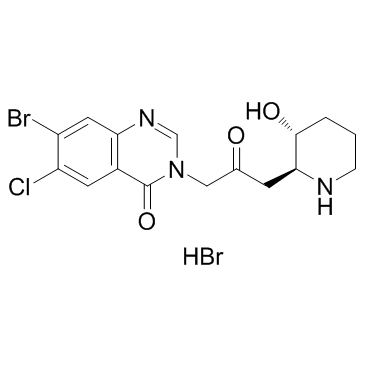64924-67-0
| Name | Halofuginone Hydrobromide |
|---|---|
| Synonyms | 7-bromo-6-chloro-3-[3-[(2S,3R)-3-hydroxypiperidin-2-yl]-2-oxopropyl]quinazolin-4-one,hydrobromide |
| Description | Halofuginone hydrobromide (RU-19110 hydrobromide) is a less-toxic form of Febrifugine, which is isolated from the plant Dichroa febrifuga[1]. Halofuginone inhibits prolyl-tRNA synthetase in an ATP-dependent manner with a Ki of 18.3 nM[2]. Halofuginone attenuates osteoarthritis (OA) by inhibition of TGF-β activity[3]. |
|---|---|
| Related Catalog | |
| Target |
Ki: 18.3±0.5 nM (prolyl-tRNA synthetase)[2] |
| In Vitro | Halofuginone competitively inhibits prolyl-tRNA synthetase by occupying both the prolineand tRNA-binding pockets of prolyl-tRNA synthetase[1]. The IC50 of Halofuginone is 114.6 and 58.9 nM in KYSE70 and A549 cells. The IC50s of Halofuginone for NRF2 are 22.3 and 37.2 nM in KYSE70 and A549 cells, respectively. The IC50 of Halofuginone for global protein synthesis is 22.6 and 45.7 nM in KYSE70 and A549 cells, respectively[1]. The amount of NRF2 protein is significantly decreased in the presence of Halofuginone in both the KYSE70 and A549 cell lines. NRF2 mRNA levels are not decreased, but rather are increased after application of Halofuginone to both KYSE70 and A549 cells, indicating that Halofuginone acts to decrease NRF2 protein expression at the post-transcriptional level. Time-course studies show that Halofuginone decreases NRF2 protein expression in KYSE70 and A549 cells within 12 hours of treatment[1]. |
| In Vivo | Halofuginone attenuates progression of OA in anterior cruciate ligament transection (ACLT) mice. The optimal dose (1 mg/kg body weight) is identified using multiple concentrations of HF (0.2, 0.5, 1 or 2.5 mg/kg) injected every other day for 1 month post surgery. Lower concentration (0.2 or 0.5 mg/kg) has minimal effects on subchondral bone and higher concentration (2.5 mg/kg) induces proteoglycan loss in articular cartilage[3]. Halofuginone (0.25-mg/kg, intraperitoneally) decreases NRF2 protein levels in tumors. While the tumor volumes do not change substantially between treatments with the vehicle, Halofuginone(0.25 mg/kg, intraperitoneally injected, every day) or cisplatin alone, combined treatment with Halofuginone and Cisplatin significantly suppresses the tumor volume compared to treatment with Halofuginone or cisplatin alone[1]. |
| References |
| Boiling Point | 595.8ºC at 760 mmHg |
|---|---|
| Melting Point | 247° (dec) |
| Molecular Formula | C16H18Br2ClN3O3 |
| Molecular Weight | 495.59300 |
| Flash Point | 314.1ºC |
| Exact Mass | 492.94000 |
| PSA | 84.22000 |
| LogP | 3.17140 |
| Storage condition | 2-8℃ |
| Symbol |

GHS07 |
|---|---|
| Signal Word | Warning |
| Hazard Statements | H302 |
| Hazard Codes | Xn |
| Risk Phrases | 22 |
| RIDADR | UN2811 - class 6.1 - PG 1 - EHS - Toxic solids, organic, n.o.s., HI: all |
| RTECS | VA2397066 |
